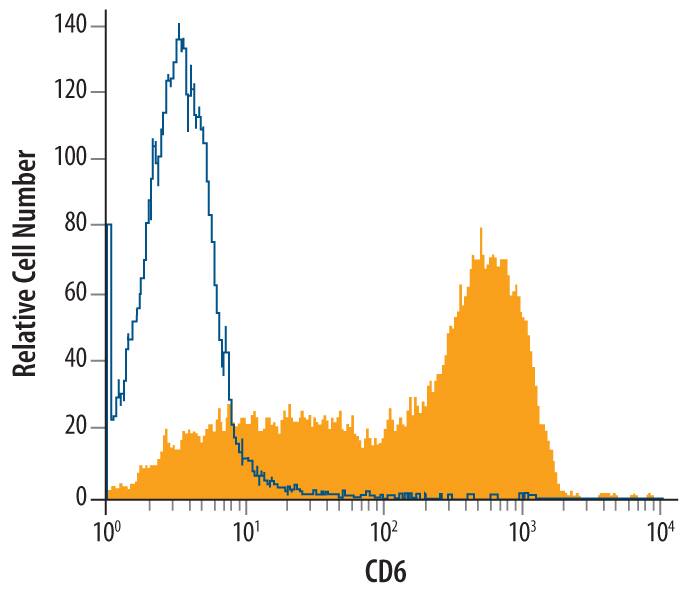Human CD6 Antibody
R&D Systems, part of Bio-Techne | Catalog # AF627


Key Product Details
Species Reactivity
Validated:
Cited:
Applications
Validated:
Cited:
Label
Antibody Source
Product Specifications
Immunogen
His18-Glu398
Accession # Q8WWJ7
Specificity
Clonality
Host
Isotype
Endotoxin Level
Scientific Data Images for Human CD6 Antibody
Detection of CD6 in Human PBL by Flow Cytometry.
Human peripheral blood lymphocytes were stained with Goat Anti-Human CD6 Antigen Affinity-purified Polyclonal Antibody (Catalog # AF627, filled histogram) or control antibody (Catalog # AB-108-C, open histogram), followed by Fluorescein-conjugated Anti-Goat IgG Secondary Antibody (Catalog # F0109).Applications for Human CD6 Antibody
Adhesion Blockade
CyTOF-ready
Flow Cytometry
Sample: Human peripheral blood lymphocytes
Western Blot
Sample: Recombinant Human CD6 Fc Chimera (Catalog # 627-CD)
Formulation, Preparation, and Storage
Purification
Reconstitution
Formulation
Shipping
Stability & Storage
- 12 months from date of receipt, -20 to -70 °C as supplied.
- 1 month, 2 to 8 °C under sterile conditions after reconstitution.
- 6 months, -20 to -70 °C under sterile conditions after reconstitution.
Background: CD6
CD6 is a member of the group B scavenger receptor cysteine-rich (SRCR) superfamily. CD6 is a type I membrane glycoprotein and contains three extracellular SRCR domains. CD6 is expressed at low levels on immature thymocytes and at high levels on mature thymocytes. The majority of peripheral blood T cells, a subset of B cells, and a subset of neuronal cells express CD6. CD6 is a 668 amino acid protein with a 24 amino acid predicted signal sequence, a 374 amino acid extracellular domain, and a 244 amino acid transmembrane region. The 626 amino acid murine homolog has also been identified. The human and murine proteins share 70% amino acid identity over their full-lengths.
The role of CD6 has not been fully elucidated. However, it appears to play a role as both a co-stimulatory molecule in T cell activation and as an adhesion receptor. Studies demonstrating a mitogenic effect for T cells with some CD6 specific monoclonal antibodies, in conjunction with either accessory cells or PMA and anti-CD2 mAb, support the concept of CD6 as a co-stimulatory molecule. Anti-CD6 monoclonal antibody has been used as an immunosuppressive agent for patients undergoing kidney or bone marrow allograft rejection. It has also been used to remove CD6+ T cells from donor bone marrow prior to allogeneic bone marrow transplantation. Other studies have demonstrated an adhesive role for CD6, it has been demonstrated to bind the activated leukocyte cell adhesion molecule (ALCAM, CD166). CD6/ALCAM interactions have been postulated to play a role in thymocyte development. The presence of ALCAM on neuronal cells may provide a mechanism of interaction between CD6+ T cells and ALCAM+ neuronal cells. Phosphorylation of the CD6 molecule appears to play a role in CD6-mediated signal transduction. Serine and threonine residues become hyperphosphorylated and tyrosine residues become phosphorylated when T cells are activated with anti-CD6 mAb in conjunction with PMA, anti-CD2, or anti-CD3 mAb. The CD6 intracellular domain contains regions that can interact with SH2 or SH3 containing proteins. However, the signaling pathways have not been elucidated.
References
- Gangemi, R.M. et al. (1989) J. Immunol. 143:2439.
- Aruffo, A. et al. (1991) J. Exp. Med. 174:949.
- Swack, J.A. et al. (1991) J. Biol. Chem. 266:7137.
- Robinson, W.H. et al. (1995) Eur. J. Immunol. 25:2765.
- Whitney, G. et al. (1995) Mol. Immunol. 32:89.
- Starling, G.C. et al. (1996) Eur. J. Immunol. 26:738.
- Degen, W.G. et al. (1998) Am. J. Pathol. 152:805.
- Swack, J.A. et al. (1989) Mol. Immunol. 26:1037.
- Pawelec, G. and H.J. Buhring (1991) Hum. Immunol. 31:165.
- Osorio, L.M. et al. (1995) Cell Immunol. 166:44.
- Robinson, W.H. et al. (1995) J. Immunol. 155:4739.
- Singer, N.G. et al. (1996) Immunology 88:537.
- Aruffo, A. et al. (1997) Immunol. Today 18:498.
Alternate Names
Gene Symbol
UniProt
Additional CD6 Products
Product Documents for Human CD6 Antibody
Product Specific Notices for Human CD6 Antibody
For research use only